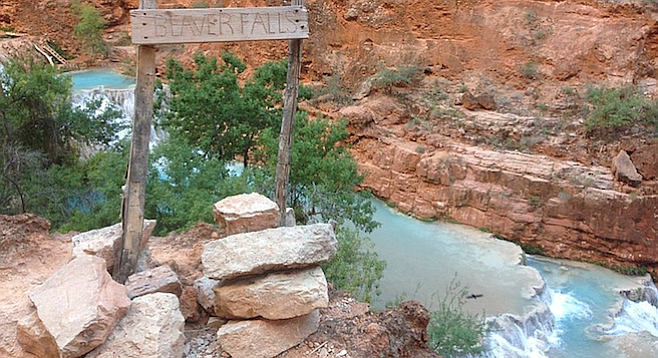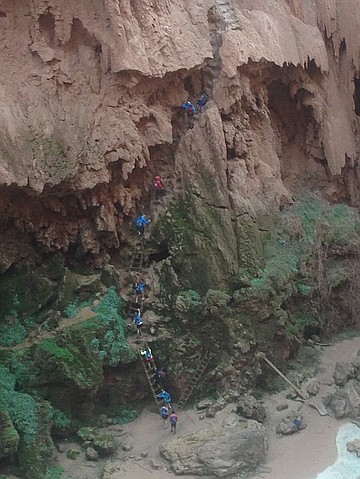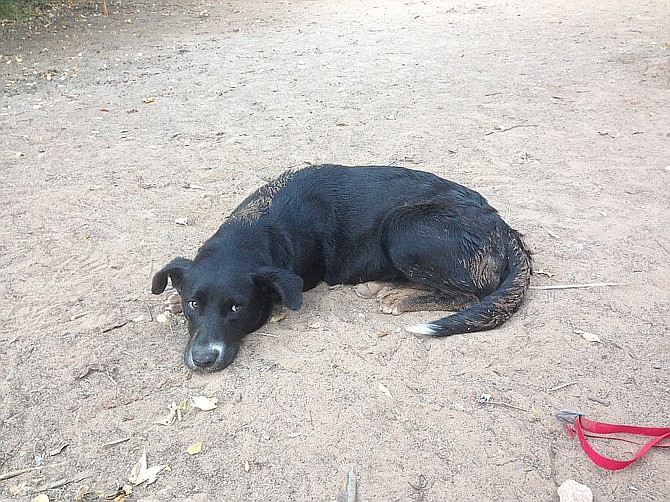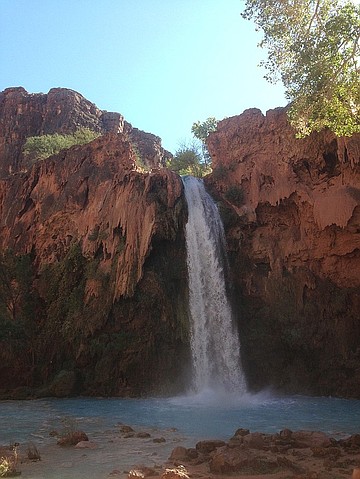 Facebook
Facebook
 X
X
 Instagram
Instagram
 TikTok
TikTok
 Youtube
Youtube

Adjoining the Grand Canyon on the south side of the Colorado River is a tributary canyon called Havasu, which, in the language of the Havasupai people who live there, means “blue-green water.” Havasu Canyon is known for its waterfalls, as well as the resonant blues of the pools they cascade into, accentuated as they are by white mineral deposits that line the bed of Havasu Creek.

On a recent visit, some friends and I went for a hike below Mooney Falls, the tallest of the Havasu Falls at around 200 feet. The canyon essentially forms a shelf here from one wall to the other. Deposits of travertine (a type of limestone) line the edge of the shelf and resemble a frozen mudflow with bubbles, domes, rivulets and dripping stalactites.
Descending the shelf to the canyon floor below requires negotiating a Peter Pan passage of natural and manufactured tunnels and steps carved into the rock. Towards the bottom, the going gets tricky because the waterfall produces a perpetual mist that turns the adjacent canyon walls green with moss and slick with mud. The final 60 feet or so of the descent require backing down a series of three wet wooden ladders, the last of which is approximately 20 feet tall.

After spending the day at the next waterfall down the canyon, a stepped Shangri-La called Beaver Falls, my group hiked back up toward camp and started up the Mooney Falls passage. This was at 5 p.m. and we were the last visitors coming back from the lower canyon, with one exception: along the way we had passed a group of people hiking with a dog, which was now sitting at the bottom of the passage watching our group climb the ladders. At the time it hadn’t surprised me to see a dog with the group, since the locals’ pets often hang around campsites looking for treats. Havasu dogs run the length of the canyon, from the parking lot at the canyon rim, to the village of Supai ten miles below. One place they rarely go, however, is below Mooney Falls.
This dog that sat watching us was a black border collie mix with a white patch on her forehead. It was clear that she was a she, because she was extremely pregnant. As I started up the ladder I looked at her sitting on her haunches, impassive, and for the first time it occurred to me that she shouldn’t be there at all, separated from every other dog in the canyon by slick ladders that people climbed only with the aid of chains bolted to the wall.
Concerned by her apparent predicament, I caught up with the ranger, who had climbed up just before us, and asked how she normally got out of the canyon.
“She just gets up,” he told me. Then he added, “Sometimes people help her.”
That only confused me more. I’d heard stories of visitors doing idiotic things with the local dogs, such as “helping them” out of the canyon and taking them home because they looked hungry. I could imagine someone bringing a puppy down to Beaver Falls for kicks, but the dog we saw down there was full grown and weighed at least 35 pounds. Climbing a ladder with her under one arm was out of the question.
I had briefly considered retracing my steps with my backpack and carrying the dog up with me, but I wasn’t sure she would fit in my bag. Also, wouldn’t it just be typical for a well-meaning but clueless tourist to try to lug a pregnant dog up a ladder and drop her to her death. No, that wouldn’t be appropriate, I decided, resolving that if nothing else the dog would go and lie down in the grass, away from the falls, and wait for more tourists the following day. Maybe she had been brought down as a puppy and just lived down there, a sort of pariah.
How the hell did she get pregnant then?

On my way back to camp after talking to the ranger, I detoured to shoot some photos of the falls from above. When I made it back after a half hour or so, I found the dog, who by now we were calling Sophie, lying on her back in the middle of our camp, having her belly rubbed. I doubt she’ll ever know how concerned I was on her behalf, but she did sleep at my feet that night, with one paw on my left foot, as though it belonged to her.
The next day I summarized this episode for the manager of the village’s general store. She said she had never heard of a dog going down to Beaver Falls and acted surprised when I told her about this one. Another local woman with four dogs following her overheard me tell Sophie’s tale and said, “Wow! My dogs won’t go down there. They stop at the top.”
Days later, on our last night in Havasu, I waited for the ranger at the top of the Mooney passage at 5 p.m. I told him about finding Sophie in our camp, and also about the women who told me no other dogs spend time below the falls. I asked if there was a secret route up the falls, maybe one that a dog could access even if people couldn’t. He told me no, and that he had actually seen Sophie descend the ladder at Beaver Falls — similar to the 20-footer at Mooney — headfirst, paw after paw. The first time he found her climbing Mooney Falls she was at the top of the 20 foot ladder just sitting. “She needed help up,” he said. After giving her a lift over the topmost ladder, some six feet tall, she climbed the rest of the way on her own. She’s been able to do it on her own ever since.

Sophie is a regular at Beaver Falls, but only since around August, 2016. According to the ranger, she had only been making the trip for two months. It occurred to me that her resourcefulness in climbing the ladders may have had something to do with her pregnancy. Given her appearance when we ran across her, she would have been just about two months into her term.
We didn’t see Sophie again until the hike out of Havasu Canyon. She was lying on her side in what I took to be her family’s front yard, eyes closed in the sun, no doubt dreaming of leftover dehydrated dinners and little bits of beef jerky.
More info on getting to Havasu falls, the hike and more: smartertravel.com/2008/08/06/hiking-to-havasu-falls-grand-canyon/


Adjoining the Grand Canyon on the south side of the Colorado River is a tributary canyon called Havasu, which, in the language of the Havasupai people who live there, means “blue-green water.” Havasu Canyon is known for its waterfalls, as well as the resonant blues of the pools they cascade into, accentuated as they are by white mineral deposits that line the bed of Havasu Creek.

On a recent visit, some friends and I went for a hike below Mooney Falls, the tallest of the Havasu Falls at around 200 feet. The canyon essentially forms a shelf here from one wall to the other. Deposits of travertine (a type of limestone) line the edge of the shelf and resemble a frozen mudflow with bubbles, domes, rivulets and dripping stalactites.
Descending the shelf to the canyon floor below requires negotiating a Peter Pan passage of natural and manufactured tunnels and steps carved into the rock. Towards the bottom, the going gets tricky because the waterfall produces a perpetual mist that turns the adjacent canyon walls green with moss and slick with mud. The final 60 feet or so of the descent require backing down a series of three wet wooden ladders, the last of which is approximately 20 feet tall.

After spending the day at the next waterfall down the canyon, a stepped Shangri-La called Beaver Falls, my group hiked back up toward camp and started up the Mooney Falls passage. This was at 5 p.m. and we were the last visitors coming back from the lower canyon, with one exception: along the way we had passed a group of people hiking with a dog, which was now sitting at the bottom of the passage watching our group climb the ladders. At the time it hadn’t surprised me to see a dog with the group, since the locals’ pets often hang around campsites looking for treats. Havasu dogs run the length of the canyon, from the parking lot at the canyon rim, to the village of Supai ten miles below. One place they rarely go, however, is below Mooney Falls.
This dog that sat watching us was a black border collie mix with a white patch on her forehead. It was clear that she was a she, because she was extremely pregnant. As I started up the ladder I looked at her sitting on her haunches, impassive, and for the first time it occurred to me that she shouldn’t be there at all, separated from every other dog in the canyon by slick ladders that people climbed only with the aid of chains bolted to the wall.
Concerned by her apparent predicament, I caught up with the ranger, who had climbed up just before us, and asked how she normally got out of the canyon.
“She just gets up,” he told me. Then he added, “Sometimes people help her.”
That only confused me more. I’d heard stories of visitors doing idiotic things with the local dogs, such as “helping them” out of the canyon and taking them home because they looked hungry. I could imagine someone bringing a puppy down to Beaver Falls for kicks, but the dog we saw down there was full grown and weighed at least 35 pounds. Climbing a ladder with her under one arm was out of the question.
I had briefly considered retracing my steps with my backpack and carrying the dog up with me, but I wasn’t sure she would fit in my bag. Also, wouldn’t it just be typical for a well-meaning but clueless tourist to try to lug a pregnant dog up a ladder and drop her to her death. No, that wouldn’t be appropriate, I decided, resolving that if nothing else the dog would go and lie down in the grass, away from the falls, and wait for more tourists the following day. Maybe she had been brought down as a puppy and just lived down there, a sort of pariah.
How the hell did she get pregnant then?

On my way back to camp after talking to the ranger, I detoured to shoot some photos of the falls from above. When I made it back after a half hour or so, I found the dog, who by now we were calling Sophie, lying on her back in the middle of our camp, having her belly rubbed. I doubt she’ll ever know how concerned I was on her behalf, but she did sleep at my feet that night, with one paw on my left foot, as though it belonged to her.
The next day I summarized this episode for the manager of the village’s general store. She said she had never heard of a dog going down to Beaver Falls and acted surprised when I told her about this one. Another local woman with four dogs following her overheard me tell Sophie’s tale and said, “Wow! My dogs won’t go down there. They stop at the top.”
Days later, on our last night in Havasu, I waited for the ranger at the top of the Mooney passage at 5 p.m. I told him about finding Sophie in our camp, and also about the women who told me no other dogs spend time below the falls. I asked if there was a secret route up the falls, maybe one that a dog could access even if people couldn’t. He told me no, and that he had actually seen Sophie descend the ladder at Beaver Falls — similar to the 20-footer at Mooney — headfirst, paw after paw. The first time he found her climbing Mooney Falls she was at the top of the 20 foot ladder just sitting. “She needed help up,” he said. After giving her a lift over the topmost ladder, some six feet tall, she climbed the rest of the way on her own. She’s been able to do it on her own ever since.

Sophie is a regular at Beaver Falls, but only since around August, 2016. According to the ranger, she had only been making the trip for two months. It occurred to me that her resourcefulness in climbing the ladders may have had something to do with her pregnancy. Given her appearance when we ran across her, she would have been just about two months into her term.
We didn’t see Sophie again until the hike out of Havasu Canyon. She was lying on her side in what I took to be her family’s front yard, eyes closed in the sun, no doubt dreaming of leftover dehydrated dinners and little bits of beef jerky.
More info on getting to Havasu falls, the hike and more: smartertravel.com/2008/08/06/hiking-to-havasu-falls-grand-canyon/
Comments